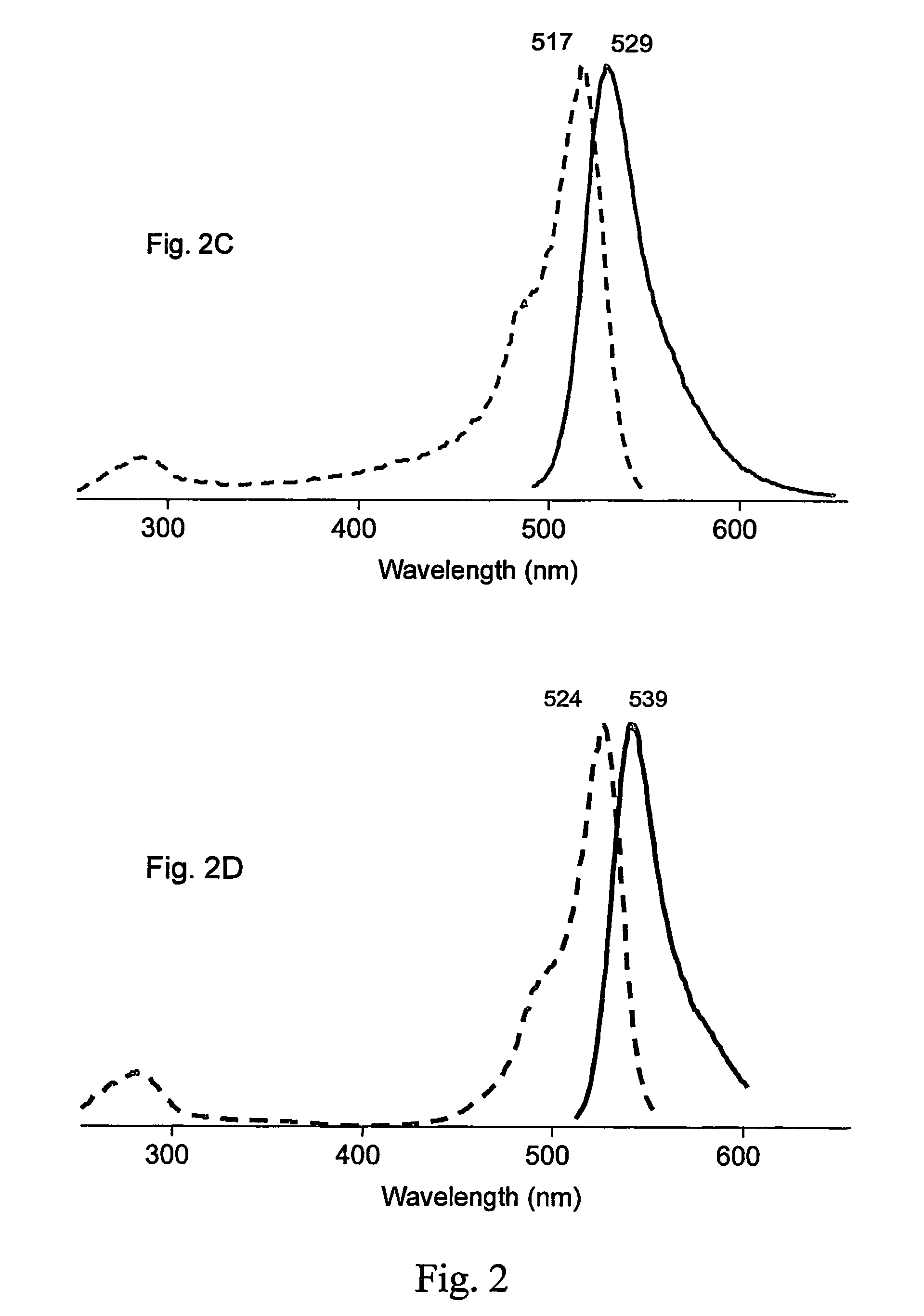Fluorescent proteins and chromoproteins from non-Aequorea hydrozoa species and methods for using same
a technology of fluorescence proteins and chromoproteins, which is applied in the field of fluorescence proteins, can solve the problems of hammering the use of these proteins in many applications, and achieve the effect of high stringency
- Summary
- Abstract
- Description
- Claims
- Application Information
AI Technical Summary
Benefits of technology
Problems solved by technology
Method used
Image
Examples
example 1
[0135]phiYFP Cloning, Sequencing and Recombinant Protein Production
[0136]Bright yellow fluorescence was detected using a fluorescent microscope in Hydromedusa Phialidium sp. (Cnidaria; Hydrozoa; Hydroida; Leptomedusae; Campanulariidae). To find the protein responsible for fluorescence in this jellyfish, a strategy based on the screening of an expression cDNA library in E. coli was chosen. Amplified cDNA samples were prepared using a SMART cDNA amplification kit (Clontech) and cloned into PCR-Script vector (Stratagene). About 105 recombinant clones were screened visually using a fluorescent stereomicroscope. Two fluorescent clones encoding the same yellow fluorescent proteins were found and were named phiYFP. The nucleic acid and amino acid sequences for phiYFP are shown in SEQ NOs: 01, 02 and 23. Comparison of phiYFP with A. victoria GFP is shown in FIG. 1. phiYFP appears to be more similar to GFP (50% identity) than to coral-derived fluorescent proteins.
[0137]To facilitate protein ...
example 2
[0138]PhiYFP Mutagenesis
[0139]The PhiYFP nucleic acid coding sequence was prepared as described above in the Example 1. We have modified the encoded wild-type protein by random mutagenesis. Random mutagenesis of phiYFP resulted in the generation of a brighter mutant named phiYFP-Y1 with a slightly altered excitation-emission spectra. This mutant contained three amino acid substitutions, specifically S2P, E174G, I201M (SEQ ID NOs: 03, 04, and 24). phiYFP-Y1 exhibited a brightness 1.5 to 2 fold higher than the wild type phiYFP in a side-by-side visual comparison of E. coli colonies expressing these fluorescent proteins. In addition, phiYFP-Y1 demonstrates a slightly red-shifted emission spectrum that peaked at 542 nm (see FIG. 2B).
[0140]Both phiYFP and phiYFP-Y1 proteins were found to be dimeric. It was demonstrated by protein gel-electrophoresis of non-heated protein samples (see Baird et al., supra, 2000). Under these conditions these FPs migrated as yellow fluorescent band at about...
example 3
[0144]hydr1GFP Cloning, Sequencing and Recombinant Protein Production
[0145]Bright green fluorescence was detected using a fluorescent microscope in a hydromedusa 1 (about 1 mm in length, FIG. 4) of sub-order Anthomedusae (Cnidaria, Hydrozoa, Anthomedusae). To search for the gene responsible for the fluorescence in this jellyfish, a strategy based on screening of an expression cDNA library in E. coli was implemented. Amplified cDNA samples were prepared using a SMART cDNA amplification kit (Clontech) and cloned into the PCR-Script vector (Stratagene). About 105 recombinant clones were screened visually using a fluorescent stereomicroscope. Three fluorescent clones were identified, each encoding the same green fluorescent protein, which was named hydr1GFP. The nucleotide and amino acid sequences for this protein are shown in SEQ ID NOS: 11, 12, and 28. A comparison of hydr1GFP with A. victoria GFP is shown in FIG. 1. hydr1GFP appears to be more similar to GFP (37% identity) than to fl...
PUM
| Property | Measurement | Unit |
|---|---|---|
| wavelength | aaaaa | aaaaa |
| time | aaaaa | aaaaa |
| time | aaaaa | aaaaa |
Abstract
Description
Claims
Application Information
 Login to View More
Login to View More - R&D
- Intellectual Property
- Life Sciences
- Materials
- Tech Scout
- Unparalleled Data Quality
- Higher Quality Content
- 60% Fewer Hallucinations
Browse by: Latest US Patents, China's latest patents, Technical Efficacy Thesaurus, Application Domain, Technology Topic, Popular Technical Reports.
© 2025 PatSnap. All rights reserved.Legal|Privacy policy|Modern Slavery Act Transparency Statement|Sitemap|About US| Contact US: help@patsnap.com



